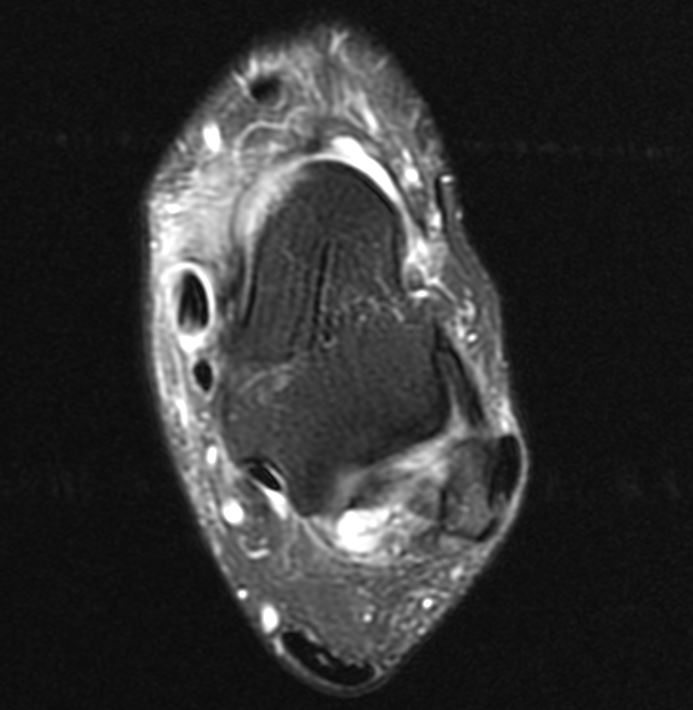[1]
Ross MH, Smith MD, Mellor R, Vicenzino B. Exercise for posterior tibial tendon dysfunction: a systematic review of randomised clinical trials and clinical guidelines. BMJ open sport & exercise medicine. 2018:4(1):e000430. doi: 10.1136/bmjsem-2018-000430. Epub 2018 Sep 19
[PubMed PMID: 30271611]
Level 1 (high-level) evidence
[2]
Holmes GB Jr, Mann RA. Possible epidemiological factors associated with rupture of the posterior tibial tendon. Foot & ankle. 1992 Feb:13(2):70-9
[PubMed PMID: 1349292]
Level 2 (mid-level) evidence
[3]
Manske MC, McKeon KE, Johnson JE, McCormick JJ, Klein SE. Arterial anatomy of the tibialis posterior tendon. Foot & ankle international. 2015 Apr:36(4):436-43. doi: 10.1177/1071100714559271. Epub 2014 Nov 19
[PubMed PMID: 25411117]
[4]
Uchiyama E, Kitaoka HB, Fujii T, Luo ZP, Momose T, Berglund LJ, An KN. Gliding resistance of the posterior tibial tendon. Foot & ankle international. 2006 Sep:27(9):723-7
[PubMed PMID: 17038285]
[5]
Jahss MH. Spontaneous rupture of the tibialis posterior tendon: clinical findings, tenographic studies, and a new technique of repair. Foot & ankle. 1982 Nov-Dec:3(3):158-66
[PubMed PMID: 7152401]
[6]
Anderson JG, Harrington R, Ching RP, Tencer A, Sangeorzan BJ. Alterations in talar morphology associated with adult flatfoot. Foot & ankle international. 1997 Nov:18(11):705-9
[PubMed PMID: 9391815]
[7]
Mosier SM, Lucas DR, Pomeroy G, Manoli A 2nd. Pathology of the posterior tibial tendon in posterior tibial tendon insufficiency. Foot & ankle international. 1998 Aug:19(8):520-4
[PubMed PMID: 9728698]
[8]
Mann RA, Thompson FM. Rupture of the posterior tibial tendon causing flat foot. Surgical treatment. The Journal of bone and joint surgery. American volume. 1985 Apr:67(4):556-61
[PubMed PMID: 3980501]
[9]
Deland JT, Page A, Sung IH, O'Malley MJ, Inda D, Choung S. Posterior tibial tendon insufficiency results at different stages. HSS journal : the musculoskeletal journal of Hospital for Special Surgery. 2006 Sep:2(2):157-60. doi: 10.1007/s11420-006-9017-0. Epub
[PubMed PMID: 18751830]
[10]
Ellis SJ, Deyer T, Williams BR, Yu JC, Lehto S, Maderazo A, Pavlov H, Deland JT. Assessment of lateral hindfoot pain in acquired flatfoot deformity using weightbearing multiplanar imaging. Foot & ankle international. 2010 May:31(5):361-71. doi: 10.3113/FAI.2010.0361. Epub
[PubMed PMID: 20460061]
[11]
Younger AS, Sawatzky B, Dryden P. Radiographic assessment of adult flatfoot. Foot & ankle international. 2005 Oct:26(10):820-5
[PubMed PMID: 16221454]
[12]
Nielsen MD, Dodson EE, Shadrick DL, Catanzariti AR, Mendicino RW, Malay DS. Nonoperative care for the treatment of adult-acquired flatfoot deformity. The Journal of foot and ankle surgery : official publication of the American College of Foot and Ankle Surgeons. 2011 May-Jun:50(3):311-4. doi: 10.1053/j.jfas.2011.02.002. Epub 2011 Mar 31
[PubMed PMID: 21458301]
[13]
Imhauser CW, Abidi NA, Frankel DZ, Gavin K, Siegler S. Biomechanical evaluation of the efficacy of external stabilizers in the conservative treatment of acquired flatfoot deformity. Foot & ankle international. 2002 Aug:23(8):727-37
[PubMed PMID: 12199387]
[14]
Myerson MS, Badekas A, Schon LC. Treatment of stage II posterior tibial tendon deficiency with flexor digitorum longus tendon transfer and calcaneal osteotomy. Foot & ankle international. 2004 Jul:25(7):445-50
[PubMed PMID: 15319100]
[15]
Kadakia AR, Haddad SL. Hindfoot arthrodesis for the adult acquired flat foot. Foot and ankle clinics. 2003 Sep:8(3):569-94, x
[PubMed PMID: 14560906]
[16]
Pellegrini MJ, Schiff AP, Adams SB Jr, DeOrio JK, Easley ME, Nunley JA 2nd. Outcomes of Tibiotalocalcaneal Arthrodesis Through a Posterior Achilles Tendon-Splitting Approach. Foot & ankle international. 2016 Mar:37(3):312-9. doi: 10.1177/1071100715615398. Epub 2015 Nov 17
[PubMed PMID: 26578482]
[17]
Smith JT, Bluman EM. Update on stage IV acquired adult flatfoot disorder: when the deltoid ligament becomes dysfunctional. Foot and ankle clinics. 2012 Jun:17(2):351-60. doi: 10.1016/j.fcl.2012.03.011. Epub 2012 Apr 10
[PubMed PMID: 22541531]
[18]
Pomeroy GC, Pike RH, Beals TC, Manoli A 2nd. Acquired flatfoot in adults due to dysfunction of the posterior tibial tendon. The Journal of bone and joint surgery. American volume. 1999 Aug:81(8):1173-82
[PubMed PMID: 10466651]
[19]
Iossi M, Johnson JE, McCormick JJ, Klein SE. Short-term radiographic analysis of operative correction of adult acquired flatfoot deformity. Foot & ankle international. 2013 Jun:34(6):781-91. doi: 10.1177/1071100713475432. Epub 2013 Feb 5
[PubMed PMID: 23386748]
[20]
Alvarez RG, Marini A, Schmitt C, Saltzman CL. Stage I and II posterior tibial tendon dysfunction treated by a structured nonoperative management protocol: an orthosis and exercise program. Foot & ankle international. 2006 Jan:27(1):2-8
[PubMed PMID: 16442022]
[21]
Pinney SJ, Lin SS. Current concept review: acquired adult flatfoot deformity. Foot & ankle international. 2006 Jan:27(1):66-75
[PubMed PMID: 16442033]
[22]
Coetzee JC, Hansen ST. Surgical management of severe deformity resulting from posterior tibial tendon dysfunction. Foot & ankle international. 2001 Dec:22(12):944-9
[PubMed PMID: 11783917]

